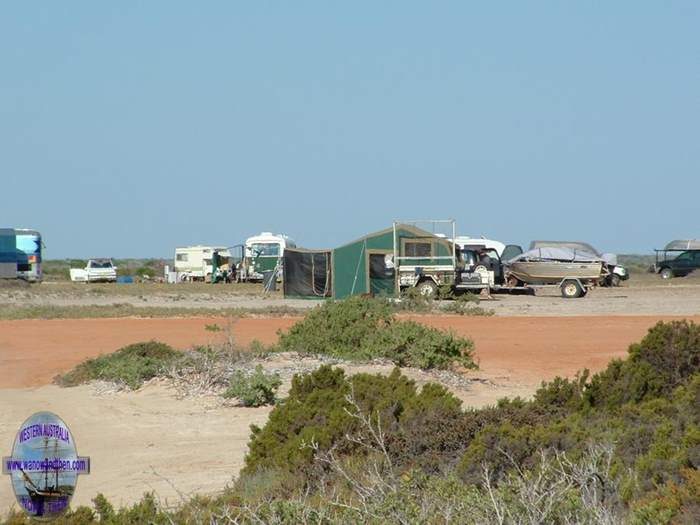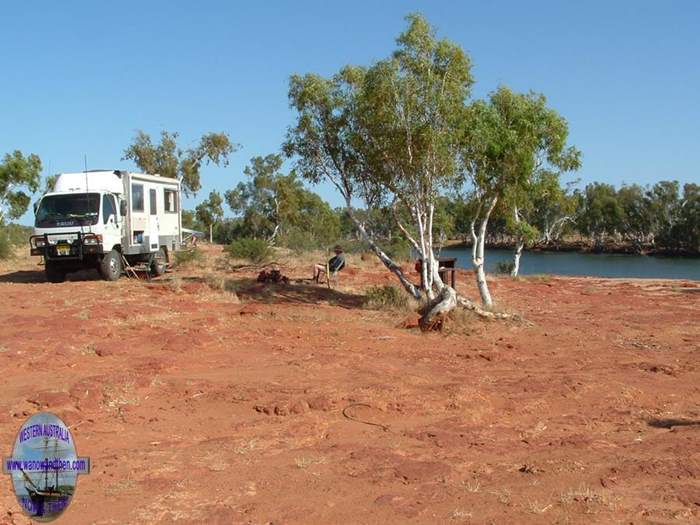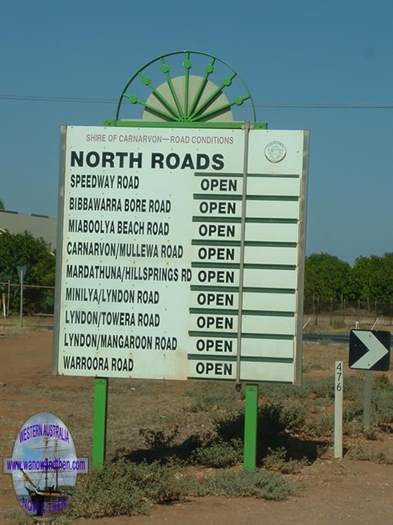|
|
|||
|
|
|
|
|
|
|
|||

|
|
|
|
|
Travelling north |
|
|
Every May Australia seems to take on a slight lean to the North and thousands of Grey Nomads pack up the caravan and head north to escape the wet, cold, southern winter.
Once the northern temperatures begin to drop to more habitable levels of about 30 degrees Celsius, those who are lucky enough to be able to do so, head for a series of campgrounds and caravan parks that stretch from Bush Bay in the West, to Groper Creek in Queensland.
Although there are hundreds of caravan parks for those who like to have all the modern amenities available, there are also many bush camps that are favoured by those with a more independent spirit.
It is the bush camps that provide the greatest camaraderie and will reward those who stay there for any length of time with never to be forgotten experiences. The freedom of picking your own site by the sea and setting up camp just as you please means that the people who frequent these sites are all like minded. If you are new to the campsite and don't know anyone, making new friends is as simple as pulling up a chair at happy hour, introducing yourself, and sitting down to have a good old chin wag (and a beer or two).
After you have made a few new friends you will probably be asked if you need anything in town when they go in and when you go into town you can ask the same question. That's just the way these campsites operate. When you are in town you can leave your camp, safe in the knowledge that those camped around you will keep an eye on things for you. There are usually lone fishermen who welcome company in their boats, so even if you don't have a boat of your own, it is likely that someone will ask you to go out in theirs.
Bush camps seem to have many things in common and the first one you will become familiar with is the 10 or 20 kilometres of gravel road you need to cross to get to most of them. The roads vary greatly in quality and the condition varies depending on the amount of rain and the number of vehicles using the road since it was last graded.
Most roads are passable to two wheel drive vehicles. All sorts of motor homes, caravans and converted buses make their way along them so if you are unused to driving on unsealed roads it is best to go slowly and take great care at all bends and rises.
In all bush camps a camping etiquette should be observed. If you don't like generators then park well away from those who use them (and many do). If you do have a generator don't run it out on a long lead and point it at your neighbour. Run it only when everyone else uses theirs. On some campsites you are only permitted to use generators between certain hours. Keep radio and TV noise to a minimum. If you have a dog then keep it on a lead at all times in campsites. When you first set up camp don't set up too close to other people. Basically these unwritten rules are just common sense. If you treat other people the way you like to be treated then you will have a happy stay.
The first of the winter campsites is about 30 kilometres south of Carnarvon. Bush Bay and its southern neighbour New Beach are only 15 kilometres off Highway One. After rains the access roads can be closed but rain in the north is infrequent in the winter months and being stranded at the campsite is rare.
Bush Bay (the northern site) is the larger of the two and is most suited to big caravans, motor homes and converted buses. New Beach has much less room to camp and is more suited to tents and camper trailers as it is more protected from the prevailing south westerly winds that blow in from Shark Bay.
Care has to be taken when setting up camp anywhere along this coast as high tides can cover areas of the campsites closest to the sea. Having an up-to-date tide chart not only helps you to catch fish, it may save you from being swamped.
Bush Bay is one of the last places on the West Coast that is designated for netting. A license is required for any kind of netting in Western Australia and they can be obtained from any Post Office or Fisheries Office. The main target for those using set nets is the sea mullet. Mullet tends to be a much maligned fish by those who have only eaten the varieties living in estuaries. The sea mullet is a vastly different fish when it comes to table fare, so having a net if you stay any length of time at Bush Bay is a very good idea.
Other fish caught in the set net include bream, shark and tailor. There are quite a few rules about how to net and these rules are enforced very strictly so read the booklet that comes with your license and avoid the hefty fines that are imposed for breaking the rules.
The water at Bush Bay is very shallow for a very long way out, but boating is still possible if you find the channels that take you into deep water about 3 kilometres off shore. In deep water you can catch all sorts of fish including huge mulloway, sharks and snapper. In the summer months crabs and squid are all over the place but if you go wading in the shallows wear stout footwear as stingrays are very common.
As of 2008, Bush Bay and New Beach were the last of the remaining free campsites on the coast. This may change at any time but camping fees at other sites under the control of the Carnarvon Shire are very reasonable.
Perhaps this all sounds too good to be true and to some extent it is. With all the good things that Bush Bay has to offer there are some negative aspects that travellers need to be aware of.
In the warmer months the area can be infested with sand flies. These small biting pests are the curse of the North. Some people react badly to their bites and have to be treated by a doctor. There are all sorts of bush cures and remedies talked about by the camp fire at night including Dettol, Meths, Baby oil, cold tea and many others. The best method to avoid being bitten is to cover up and use a DEET based repellent like Rid. If you do get bitten then we reccommend boiling some water and placing a metal spoon in it. Take the spoon out, count to ten and then put it on one of the bites. Keep it on as long as you can stand it. Repeat this treatment for every bite. We have found that this does help.
During the cold months, on the odd days when an easterly wind blows, the bush fly makes its presence known in no uncertain terms. They teem in their millions and can drive you to distraction. Then the wind changes direction and they are gone again.
Then there is THE WIND. For days on end it can howl in across Shark Bay from the south west. Setting up the annexe the wrong way round when the wind isn't blowing can be a big mistake. In this area it is always best to point your annexe towards the north east.
It is possible to camp at Bush Bay almost any time of the year but you have to be aware of the problems you might face during the different seasons. The only thing that puts an end to camping is long periods of rain as the roads leading in become completely impassable.
Compared with almost all the other sites along the West Coast, Bush Bay is the closest to a town (45Km) which enables you to regularly pick up supplies and collect your mail. Other sites in the vicinity include Gladstone to the south, Miaboolya Beach (now closed to camping) just north of Carnarvon, Rocky Pool on the Gascoyne River to the east of Carnarvon and The Blowholes about 75 kilometres north of Carnarvon.
None of these sites have all the advantages of Bush Bay but they are worth quickly reviewing as each is different.
The most southerly, Gladstone, is accessed by a 6 kilometre dirt road that turns off the highway 20 kilometres south of the Wooramel Roadhouse. It is the most isolated of all the sites in the area but in other respects it is similar to Bush Bay. Gladstone was once a port (of sorts) and a stone groin still sticks out into the sea (when the tide is in).
There are good toilets and a dump point at Gladstone and fees are $5.50 per person per night.
Miaboolya Beach was the closest to Carnarvon but surprisingly it is the least pleasant of all the alternatives in any case it is no longer available as a campsite. The beach cannot be seen from the car park and is a good 300 metres away across the dunes. At certain times of the year the beach is covered with rotting seaweed and can be very unattractive.
To the east of Carnarvon along the Gascoyne Junction Road, is a very attractive (ex-)camp called Rocky Pool. The road is now sealed for all but the last 4 kilometres of the 34 kilometres you need to travel to get there. If there is water in the pool then you will see plenty of bird life as well as being able to take a nice cool dip. It is one of those tranquil, quiet places that have a magic all of its own, especially at sunrise or sunset. Sadly the shire has decided to close this as a campsite. It is a silly decision and one we hope will eventually be reversed.
The last of the campsites near Carnarvon is located around 75 kilometres north of town near Point Quobba. The Blowholes that you pass on the way to the campsite are a tourist attraction on their own, as water spouts shoot over 30 metres into the air when the tide is right. This section of coast is far more dangerous than the placid waters of Bush Bay. Signs warn of king waves and you must always keep an eye on the sea if fishing from the rocks. Many people do take the risk as the fishing here can be excellent.
The campsite is located just south of Point Quobba, behind an island that shelters part of the coast giving a relatively safe anchorage. Fishing from boats here is only recommended for those who are very experienced with rough water. The sheltered area is a marine sanctuary and no fishing at all is allowed behind the island. Swimming may not be a good idea as there are a lot of sharks in these waters. Very large sharks can be seen patrolling shallow water near the beach some evenings.
Because the sea is quite deep just off the coast you can regularly see whales as they migrate along the coast if you are in the area at the right time of year. In spring, walking along the coastal tracks is very rewarding as wildflowers grow in abundance.
There are a few station campsites along the coast to the north of Point Quobba but they are remote, rough and almost impossible to get to in anything but a 4 wheel drive.
Carnarvon shire WAS one of the best in Western Australia when it comes to providing bush camping areas. The new 'anti-free choice' attitude of the shire will no doubt start to be felt by businesses in town as travellers vote with their wheels and keep on going to places that offer better bush camping alternatives.
At the time of updating this page (April 2015) the shire website clearly states that there is 'NO FREE CAMPING' available and we are unsure of the current status of Bush Bay. We have asked the shire for clarification but so far they have not responded.
It is very sad to see such a great area starting to lose so many wonderful bush campsites.
|
|
|
Become a supporter of this website for just $5 a month
|













